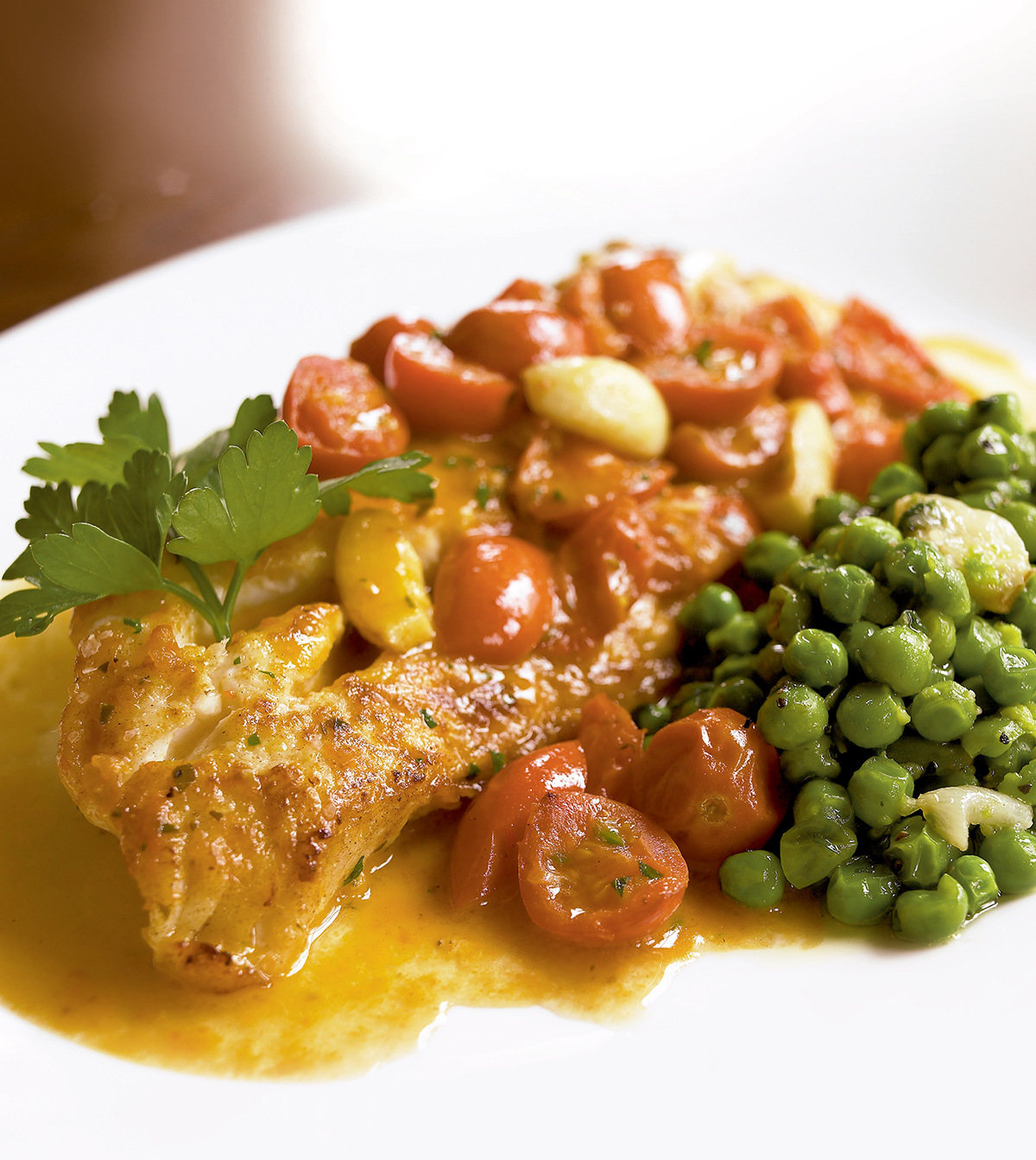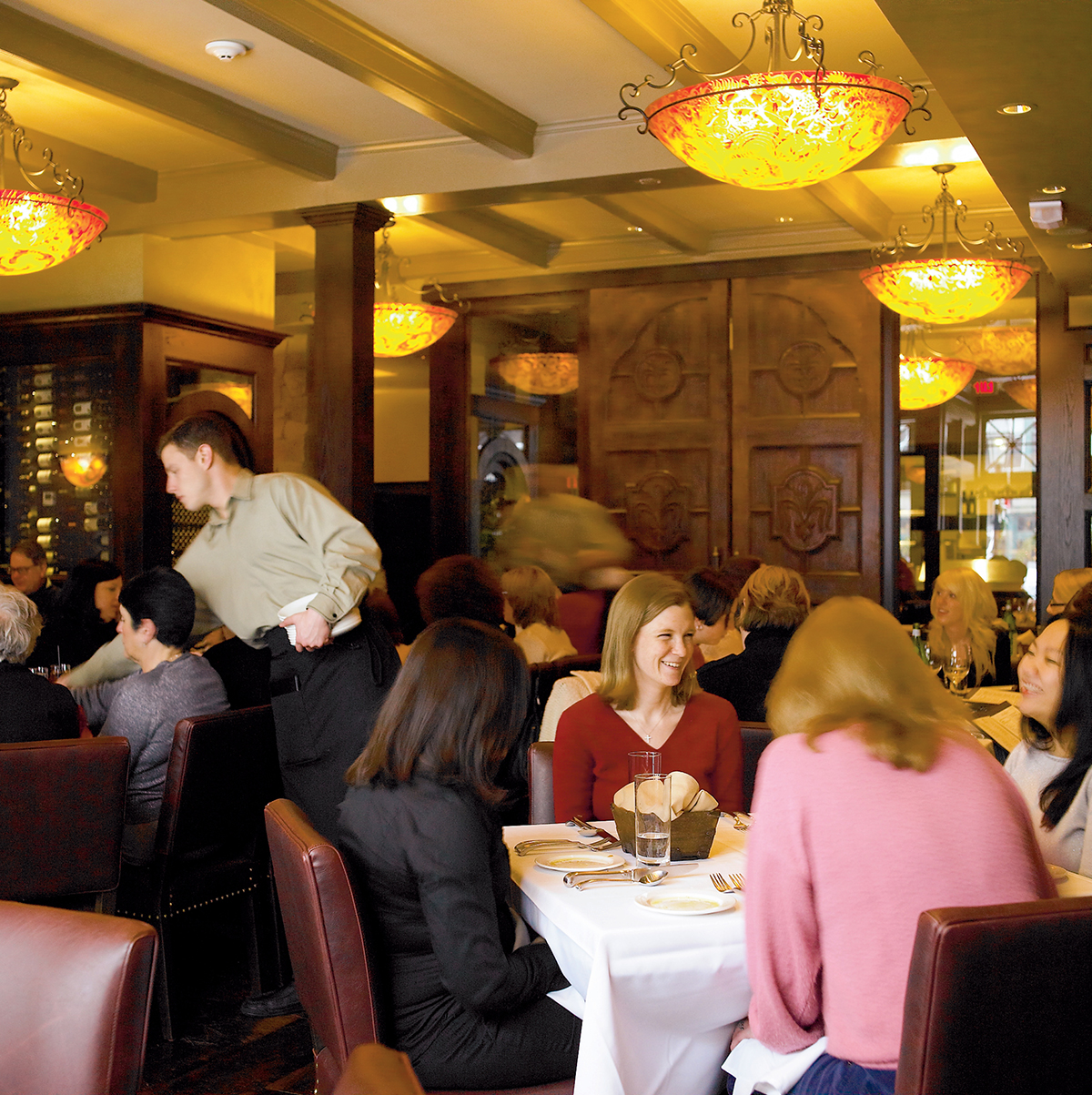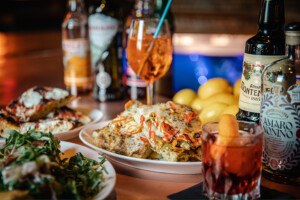Dining Out: Losing Something in the Translation

Georges Bank cod with cherry tomatoes, garlic, acqua pazza, and peas. (Photograph by Heath Robbins)
You might think the last thing Beacon Hill needed was another club, but the crowds at the new Toscano prove otherwise. The Brahmins who adopted the original, modest Charles Street restaurant soon after it opened in 1983 have now been joined at its reincarnated version by an un-silent majority of the city’s movers and shakers: pols from the State House and City Hall and the kind of businesspeople who flock to Grill 23 and Davio’s.
The new clientele is more noteworthy than the new food. David D’Alessandro, late of John Hancock, didn’t make his name as a Brahmin wannabe, but he bought the place anyway because he liked it and because his son, Andrew, is pursuing a career in restaurants. That they are keeping Toscano in the same space, with the same cooks—some of whom have worked there for decades—is a gift to the neighborhood. Along with a broader menu, father and son knew exactly what they needed to keep both the old guard and the younger, louder crowd coming in: an energy that says “power.”
The lavish new décor says the same thing. Where there was exposed brick and little copper pans that looked as if they came from a Florentine souvenir shop, there is now dark chestnut-colored wood—lots of it. Where there were the rush-seat chairs of a simple trattoria, there are now solid, leather-covered ones. The opulent, masculine look still feels Italian, but in a way that evokes The Sopranos more than it does the old country.
And that’s the main difference between the old Toscano and the new one. Vinicio Paoli, the longtime owner, was raised and trained in Tuscany. He was rough-hewn and blustery, and his food had overtones of the stodgy continental fare that was taught in the culinary schools of his era. But the basis of what he cooked and served was authentic Tuscan—food so plain that at the height of Todd English–style excess, it appeared boringly austere. (Hence its strong appeal to Brahmins.)
Although the cooks at the new Toscano are almost identical to the largely Central American brigade Paoli trained, the food seems, with few exceptions, to have lost the austerity and authenticity that distinguished Ristorante Toscano, as it used to be named, from every other Italian restaurant in town. Perhaps that’s because without Paoli, Toscano has no executive chef: The cooks work under the management team of Andrew D’Alessandro and partner Richard Cacciagrani, and are supervised by kitchen manager Samuel Gomez. There’s plenty of meat, much bigger portions, mashed potatoes everywhere, and a surprising number of sauces that include cream and butter—but nothing too fancy. (Hence its strong appeal to power brokers and pols.) With care, you can have a perfectly fine meal, and even taste some reminders of the old place. It’s hard to get anything with much flavor, though, or anything with ideas and tastes that you’ll remember the next day, or anything you couldn’t get at a dozen restaurants in the North End, probably for less money.

Managing partners Richard Cacciagrani, left, and Andrew D’Alessandro. (Photograph by Heath Robbins)
At my first dinner, I went for the staples that had gotten me through many wintry nights: minestrone and spaghetti with tomato sauce. The clear vegetable soup ($8) had recognizable green beans, tomatoes, and other vegetable chunks, but the base was so watery and dismally dull that it stayed untouched after the first hopeful slurps. The unpleasantly slippery spaghetti ($15) was a thin cut, more like spaghettini, and the tomato sauce was distinctly tinny.
Those building blocks need to be set right before the rest can improve. Once that sauce is fixed up with a bit of substance, the pastas and pizzas will get better, too. (The thin pizza crusts also need help: They’re tough, and taste of under-risen flatbread.) The one risotto I tried, served beside osso buco ($29), had so little flavor that if it hadn’t been colored orange—theoretically from saffron—I’d have had no idea what was supposed to be in it.
But enough on the negatives. Certainly Toscano’s two main rooms were crowded during my three dinners, and several dishes came as happy surprises. Best were the gnocchi quattro formaggi ($17), big pillowy dumplings in a creamy but not overbearing sauce. I don’t remember these being this delicate and satisfying at the old Toscano, and I can easily imagine subbing them for my old default spaghetti pomodoro. Although the penne strascicate ($16) had more of that slippery pasta, the tinny notes of the tomato sauce were softened by good beef sauce, like bolognese without the milk or pork. It’s another dish that could be a regular for any pasta lover.
Main courses were more reliable, reversing the usual Italian-restaurant MO. The veal for the osso buco was bland and not as spoon-tender as I would have liked, but the tomato-vegetable sauce was bright and the portion huge. You get similar value from the other equally large and well-priced meat entrées, such as the gigantic double-cut pork chop ($24) with the notably good mashed potatoes, which have honest potato flavor and really taste homemade. The scottadito di agnello ($30), grilled frenched lamb chops you pick up with your fingers, was like the pork: a relative deal for a lot of meat, and with a pleasantly mild flavor.

Toscano’s wood-filled dining room. (Photograph by Heath Robbins)
Many diners are ordering the restaurant’s vegetable dishes, Cacciagrani told me, and the menu is generous with them. The standout was eggplant parmigiana ($14), light but substantial enough to make a main course, and with plenty of tomato sauce mellowed by cheese and enlivened by a judicious amount of garlic. It was the fought-over dish at one dinner.
Fish is better avoided, based on two of the four main courses I tried: sea bass and baby artichokes ($28) in an oily, garlicky sauce, and cod with cherry tomatoes ($26) in another poorly executed sauce, with domineering dried herbs and garlic. The accompanying oven-roasted peas were nice, though, showing the kitchen’s sure touch with vegetables. That’s true Italian.
So is the unexceptional dessert list (all $8)—Tuscans aren’t big on desserts—with a just-okay crème caramel, and zabaglione with sliced strawberries. The server-touted ricotta tart was dull, with a soggy crust, and the biscotti, something Tuscans actually do have after dinner, were stale—but from a good Florentine-origin box, and served with the delicious Tuscan dessert wine vin santo, biscotti’s perfect dipping partner.
D’Alessandro and Cacciagrani run an energetic, unpretentious staff whose enthusiasm for wine is frat-boy fun. In fact, the whole place is far livelier these days, and you’ll probably see someone you know or want to do business with. I’m glad an old friend has been given new life. Now what Toscano needs is a visionary chef with a true Tuscan touch—old or young, crusty or ingratiating—to dip a supervisory finger into the sauces before they leave the kitchen.
Toscano, 47 Charles St., Boston, 617-723-4090.
From left, ravioli with butter and sage; zabaglione with strawberries; double-cut pork chop with mashed potatoes. (Photographs by Heath Robbins)
CORBY’S PICKS
Pasta Gnocchi quattro formaggi ($17); penne strascicate ($16)
Entrées Scottadito di agnello, grilled frenched lamb chops ($30); osso buco with saffron risotto ($29); lombata di maiale, double-cut pork chop with mashed potatoes ($24)
Side Eggplant parmigiana ($14)


